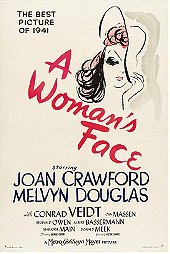A Woman’s Face is a trashy, pseudo-horror movie like film but one presented as an A-picture melodrama. I’ve watched A Woman’s Face five times as of writing this review and gets better every time I watch it. Within the last year, I’ve felt the motivation to watch the film three times, something which is almost unheard of for me; this movie is that good. I’ve now decided, screw it, this is my favourite Joan Crawford film and considering there’s tough competition from Whatever Happened to Baby Jane?, Mildred Pierce and The Women, that’s saying a lot.
Every major cast member in A Woman’s Face is superb. I know that sounds like a generalization but it’s true. Firstly there’s Conrad Veidt as Torsten Barring. I adore every second this man is on screen; he’s just so delightfully sinister but in the most absorbingly charming manner - I’m swept off my feet by his presence. I can completely buy into the romance he shares with Anna Holm (Crawford) because he looks past her facial disfigurement and is unbothered by it. Melvyn Douglas is the other great charmer of the cast, whom I’ve yet to see paired with an actress who he didn’t share great chemistry. Ossa Massen, Reginald Owen, Albert Bassermann, Marjorie Main (unrecognisable here) and Donald Meek are also all equally memorable and stand in the strong characterisations of their roles. Likewise on re-watching look out for the moments of foreshadowing (“You love children? I loathe them”).
Then there’s Crawford herself in a once in a lifetime role as a facially disfigured woman, a part few actresses would be prepared to play. Her character of Anna Holm only engages in deceitful acts because of society’s mistreatment of her since childhood but is otherwise good at heart. Anna tries to make the best for herself and doesn’t dwell into a victimhood complex (“I don’t care for pity ether”); she runs her own tavern, pursues different talents and less virtuously is involved in criminality. Regardless throughout the film my heart pours out for the poor woman and yet even with the disfigurement I still find Crawford to be incredibly beautiful in this film, nor does the disfigurement ever take away from the asset that is her stunning body. If anything the moment in which Anna returns from a shopping trip and is wearing a very excessive blouse to take attention away from her face is the one moment in the film in which her character comes off to me as pathetic sight.
A Woman’s Face is one of the few thrillers George Cukor directed with echoes of Hitchcock throughout, such as the shots of the smelter plant and a waterfall in the background (similar to the scenery in films such as Foreign Correspondent), to the film’s suspenseful scenes such as that atop the cable car. This sequence itself is absent of any music, simply allowing the sound of the nearby waterfall and the smelter plant increase the tension while the film’s climax, on the other hand, offers a sort of Ben-Hur on sleds finale. Since I consider this film far superior to Hitchcock’s thriller offering that year of Suspicion, Cukor out Hitchcocked Hitchcock. With Cukor being one of the great masters of his trade, the cinematography of A Woman’s Face is a feast for the eyes. Technically speaking, the scenes at the hospital and Anna’s subsequent unbandaging are my favourite part of the film. Along with A Woman’s Face and the 1934 medical drama Men In White, it makes me wonder if it’s just me or do medical interiors and apparatuses make for some of the best subjects to capture on film.
Being a remake of a Swedish film, there’s something somewhat unconventional about A Woman’s Face for a Hollywood film. The movie does manage to capture the essence of its Northern European setting (despite much of the cast supporting American accents) and offers a slice of Swedish culture with its dancing sequence.
I consider 1941 to be the greatest year in the history of cinema. The output of this single year is the jealous vain of entire decades and A Woman’s Face just adds to this. Melodrama seems to have a bad reputation for no good reason. Like many things, it can be done well and done poorly. A Woman’s Face represents the old Hollywood melodrama tailored to perfection.
 Login
Login